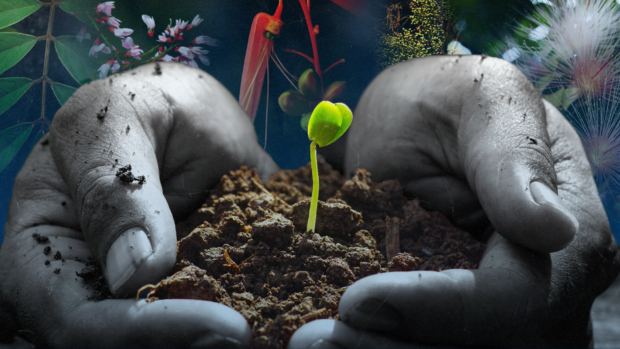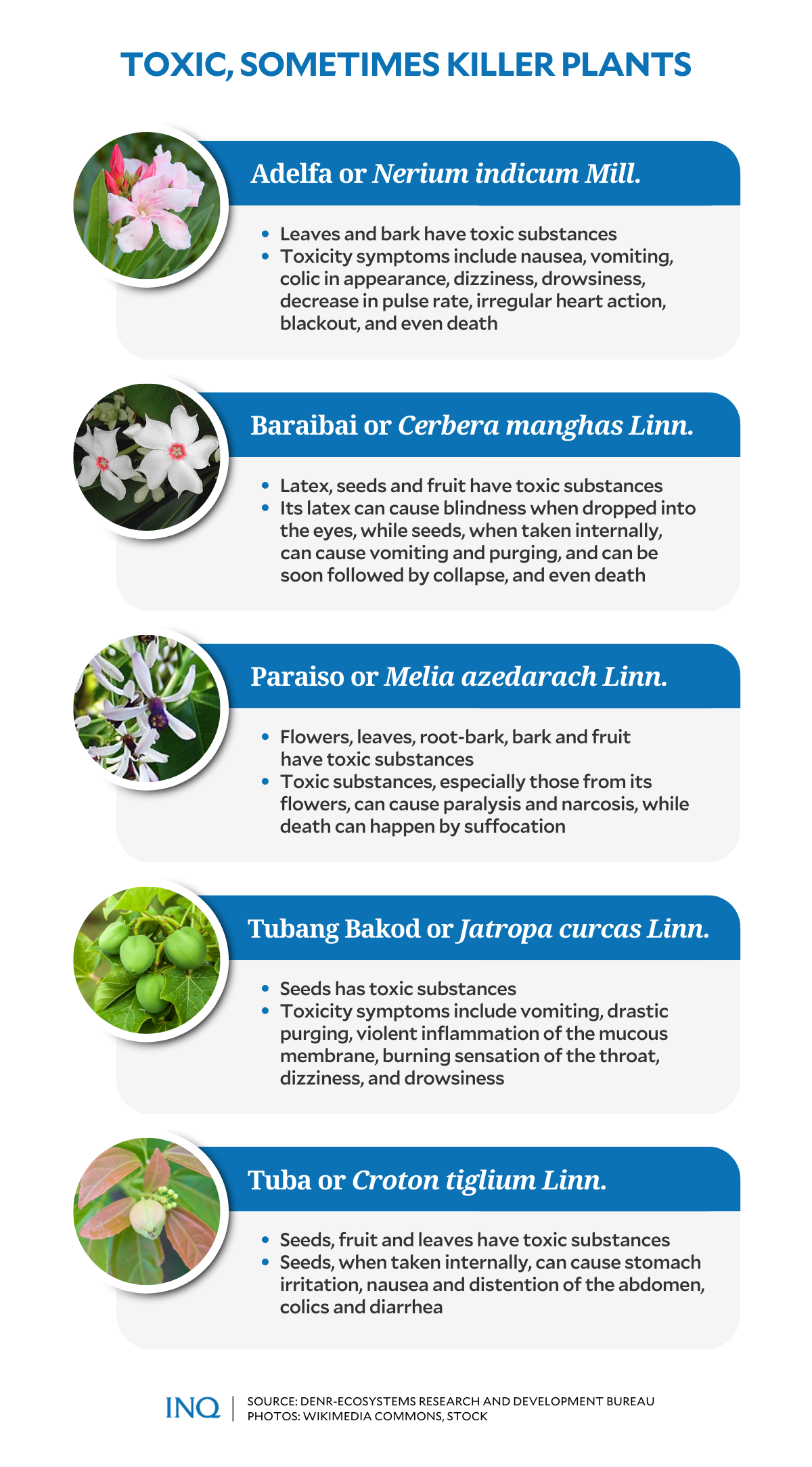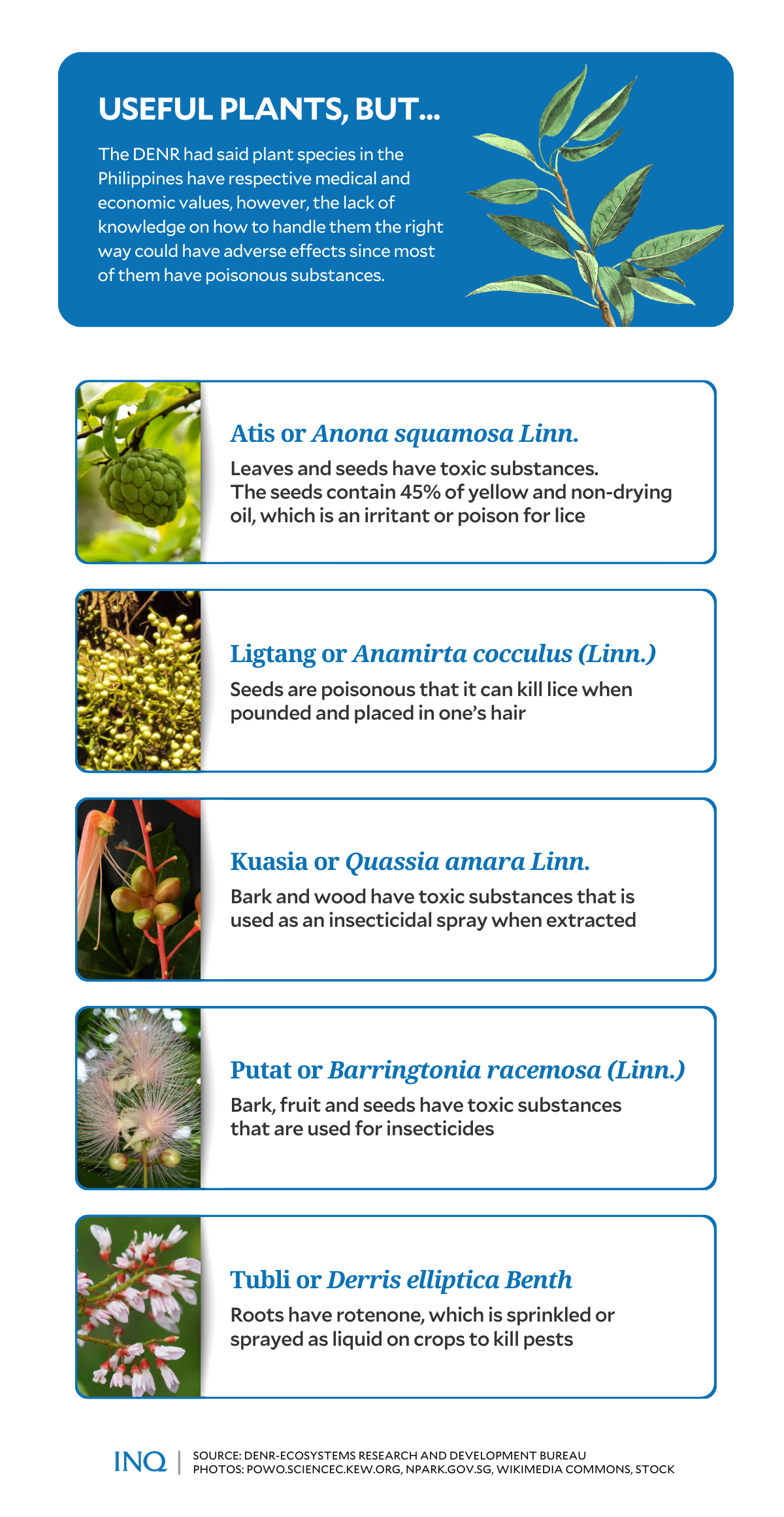Nat’l Poison Prevention Week: Know your toxic plants, their uses – MyCyberBase


COMPOSITE IMAGE: DANIELLA MARIE AGACER FROM NATIONAL PARKS, PLANTS OF THE WORLD ONLINE, STUART EXCHANGE ORG, WIKICOMMONS, WIKIMEDIA COMMONS
MANILA, Philippines—With over 14,000 species of plants, the Philippines is an “oasis of botanical treasure,” but as the Department of Environment and Natural Resources (DENR) had stressed, some have toxic substances that can be dangerous if handled the wrong way.
According to the National Museum, the thousands of species of plants in the Philippines account for two-thirds of the earth’s biodiversity. Over half of the 14,000, it said, are endemic, or are found only in the country.
Some of them are even considered “medicinal” by the Philippine Institute of Traditional and Alternative Medicine, with the Department of Science and Technology even looking at the anti-COVID properties of lagundi, tawa-tawa and coconut.
READ: ‘Healing plants’ in PH offer alternative to prohibitive COVID meds
But while most species of plants have their respective health, and even economic values, the DENR’s Ecosystems Research and Development Bureau (ERDB) warned that some are considered to have “harmful or toxic effects.”
These species of plants, like tubang bakod or (Jatropa curcas Linn.) and talampunay (Datura stramonium), take the limelight as the Philippines, through Proclamation No. 1777, observes National Poison Prevention Week from June 19 to 23.
It was in 2009 when then President Gloria Macapagal-Arroyo issued Proclamation No. 1777 to “increase awareness on the preventive aspects of poisoning prevention at home, school, work and the general environment.”
READ: DID YOU KNOW: National Poison Prevention Week
Based on government data in 2009, the National Poison Management and Control Center (NPMCC) of the Philippine General Hospital was receiving an average of 10 referrals for toxicologic management.
The NPMCC said this year’s celebration was centered on coming together to prioritize the safety of people’s health and the environment: “Tungo sa Kaligtasan ng Kalusugan at Kapaligiran: Dinggin ang Panawagan.”
But while the NPMCC has a long list of poisonous substances, like sodium hypochlorite, gas and kerosene, and pesticide, INQUIRER.net will list down some of the species of plants in the Philippines that are considered poisonous.
- Adelfa (Nerium indicum Mill.)
The DENR-ERDB, in its publication “Useful Plant Species with Toxic Substance,” said adelfa, which is a kind of shrub, thrives well in sandy loam soil. While it can be propagated easily through stem cuttings and air layering, its leaves and bark are poisonous.
Likewise, its roots, when pounded, are used as an insecticide.
It was stressed that its toxicity symptoms include nausea, vomiting, colic in appearance, dizziness, drowsiness, decrease in pulse rate, irregular heart beats, blackout, and even death.
- Baraibai (Cerbera manghas Linn.)
Baraibai or buta-buta is an erect shrub that sometimes grows into a small tree as high as six meters. It has stout and cylindrical branches with leaf scars. Its leaves, meanwhile, are shiny and alternately clustered toward their ends.
Its latex, fruit and seeds contain toxic substances, though.
The latex can cause blindness when dropped into the eyes, while seeds, when taken internally, can cause vomiting and purging, and can be soon followed by collapse, and even death.
- Paraiso (Melia azedarach Linn.)
Also called bead tree, paraiso is a small to medium-sized deciduous tree growing from about six to 15 meters in height. The DENR-ERDB said its flowers, leaves, root-bark, bark and fruit have toxic substances.
These toxic substances, especially those from paraiso’s fruit, can be dangerous when handled the wrong way, and could lead to paralysis, narcosis, collapse, and eventually, death.
- Tubang Bakod (Jatropa curcas Linn.)
A smooth, erect, and branched shrub growing from two to five meters in height, tubang bakod or physic nut is propagated through its seeds and cuttings. It also has a greenish flower that is seven to eight millimeters in diameter.
Its seeds, however, are poisonous and can cause vomiting, drastic purging, violent inflammation of the mucous membrane, burning sensation of the throat, dizziness, and drowsiness.
As explained by the NPMCC, the seeds contain toxalbumin and tannic acid, which can result in symptoms, stomach irritation, and eventually, damage to the liver.
- Tuba (Croton tiglium Linn.)
Also called tubang makaisa, tuba is a spreading shrub that has alternating and ovate leaves. Resinous oil, which can have therapeutic value, can be extracted from its seeds, fruit and crushed leaves.
READ: ‘Tuba-tuba’ poisoning justifies tree cutting
It is used, too, as fish poison.
However, ingesting the seeds can cause stomach irritation. It can also cause nausea and distention of the abdomen, and colics and diarrhea, the DENR-ERDB explained.
Useful, but…
The DENR-ERDB stressed that even with the presence of toxic substances, some species of plants, even adelfa, baraibai, paraiso, tubang bakod, and tuba, are still beneficial to people.
This was the reason it pointed out that awareness of these plants and the parts with toxic substances is highly important, saying that everyone should emphasize the significance of these details.
It said people just need to have the correct information on their use and how to handle them the right way.
Atis (Anona squamosa Linn.)
A small tree with fruits seen in thick stalks, its fruits are edible and used commercially, however, its seeds contain toxic substances, so caution should always be kept in mind.
The DENR-ERDB said the seeds of atis have 45 percent yellow and non-drying oil, which is an irritant or poison for lice.
- Ligtang (Anamirta cocculus Linn.)
Ligtang is a large woody vine with gray bark and white wood, with stems that are sometimes 10 centimeters thick. With its high quality, its wood is often used for knife handles and cabinets.
Its seeds, though, are poisonous when pounded. It can kill lice when placed in the hair.
- Kuasia (Quassia amara Linn.)
It is a smooth shrub that is used in manufacturing pharmaceutical products. However, caution is especially needed when handling this since its extract can be used as an insecticidal spray.
The DENR-ERDB also stated that the extract is used as poison in fly traps.
- Putat (Barringtonia racemosa Linn.)
Putat is a tree with a smooth trunk, which can be used as hedges or fence posts. Its seeds, meanwhile, yield oil that is used for illumination.
Its bark, however, can poison fish, while its fruit can poison wild pigs.
- Tubli (Derris elliptica Benth)
Tubli is a rambling climber with branches covered with brown hair. Its seeds have rotenone, which is an odorless, colorless, and crystalline isoflavone, which is sprinkled or sprayed as a liquid against insects.
Things to keep in mind
The NPMCC said in case of exposure to the toxic substances of these species of plants, these are the things to keep in mind as “first-aid”:
- Wash the affected eyes or skin
- Do not force the patient into vomiting
- Do not drink or take milk, sugar, water, egg, or any herbal medicines
- Proceed to the nearest clinic or hospital
It said it is important to be cautious when handling or eating plants, especially those that do not need cooking. Likewise, poisonous plants should be kept away from children.
RELATED STORY: Pros and perils of indoor plants
TSB
Read Next
Subscribe to INQUIRER PLUS to get access to The Philippine Daily Inquirer & other 70+ titles, share up to 5 gadgets, listen to the news, download as early as 4am & share articles on social media. Call 896 6000.
, 2023-06-27 16:51:28 ,
#Natl #Poison #Prevention #Week #toxic #plants
for more interesting Article Visit regularly : https://mycyberbase.com/








